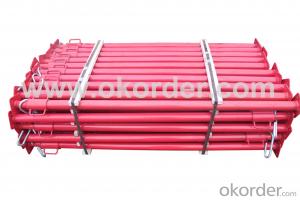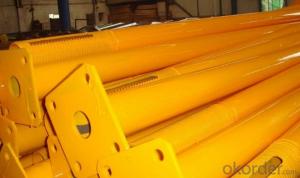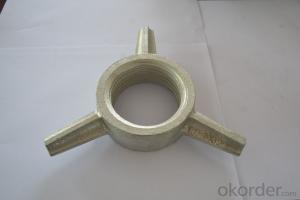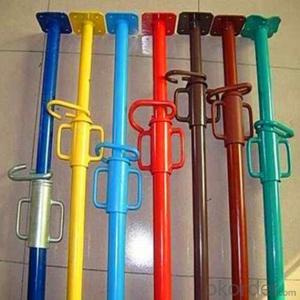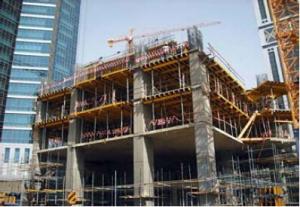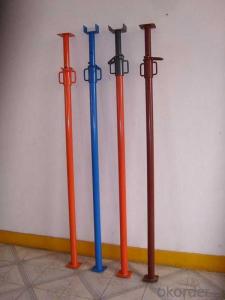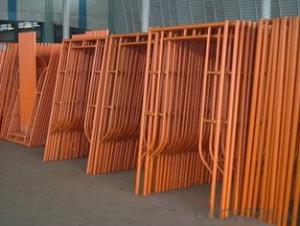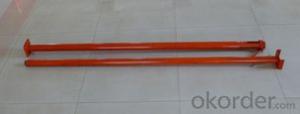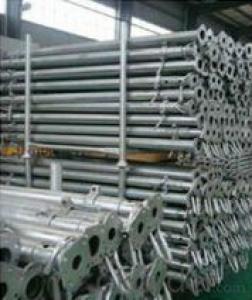cup lock scaffolding standard &cup lock scaffolding ledger OEM SERVICE, MANUFACTURER
- Loading Port:
- Tianjin
- Payment Terms:
- TT OR LC
- Min Order Qty:
- 10000 PCS
- Supply Capability:
- 10000 PCS/month
OKorder Service Pledge
OKorder Financial Service
You Might Also Like
Quick Details
| Size:: | 48.3*3.25mm | ||||
| Material:: | Steel (Q235/Q345) | Surface:: | Electro Galvanized/Self Color/Painted/HDG | Component:: | Standard, Ledger, Diagonal, Bracket, Top&Bottom cup, Ledger blade etc |
Packaging & Delivery
| Packaging Detail: | As the Requirment of Clients |
| Delivery Detail: | 20 days |
Specifications
1.OEM Service,EN74 & BS1139
2.competitive price,fast delivery,good service
3.more than ten-years' experience
4. Samples ok
Product Description
Cuplock Scaffolding System and Accessory for Construction Slab Formwork
It is a multi purpose system scaffold, suitable for access and formwork support in all types of construction of building & civil engineering projects. This complete galvanized system is probably the fastest and most-widely preferred scaffold system.
Material: Steel (Q235/Q345)
Size: 48.3*3.25mm
Surface: Electro Galvanized/Self Color/Painted/HDG
Component:
Standard, Ledger, Strengthened ledger, Transom Beam, Diagonal, Bracket, Top cup, Bottom cup, Ledger blade, etc.
Application:
Highways/Subways, Bridges, Tunnels and Fire Electrical Engineering, Marine Engineering
Advantage: Durable, Stable, Skid-proof, Antirust, Easy to assemble & Dismantle
OEM service is available
Custom-made service is available
- Q:What are the common accessories used for connecting steel props to formwork?
- The common accessories used for connecting steel props to formwork include: 1. Prop heads: These are the upper attachments that are used to support the formwork. They are usually adjustable and can be fixed at different heights to accommodate various formwork designs. 2. Prop sleeves: These are cylindrical components that are used to connect the steel props to the formwork. They are inserted into the prop heads and provide a secure connection between the prop and the formwork. 3. Prop nuts: These are used to tighten and secure the prop sleeves onto the steel props. They are typically hexagonal in shape and can be easily tightened or loosened using a wrench or spanner. 4. Prop pins: These are used to lock the prop sleeves in place once they are connected to the steel props. They prevent any accidental dislodging or movement of the formwork during construction. 5. Formwork brackets: These are additional accessories that are used to provide extra support and stability to the formwork. They are usually attached to the prop heads and can be adjusted to different angles or positions to accommodate the specific requirements of the formwork design. 6. Beam clamps: These are used to connect the steel props to horizontal beams or supports. They provide additional stability and prevent any lateral movement of the formwork. 7. Tie rods: These are used to provide horizontal or diagonal bracing to the formwork. They are connected to the prop heads and are used to counteract any lateral forces or pressures exerted on the formwork. Overall, these accessories play a crucial role in connecting the steel props to the formwork, ensuring stability, safety, and proper alignment during the construction process.
- Q:Are there any height limitations for using steel props?
- Steel props have height limitations. The maximum height of steel props varies depending on factors such as the weight they support, load distribution, and prop type and design. Typically, steel props can support vertical loads up to a certain height. If the height exceeds this limit, alternative methods like scaffolding or other structural supports may be necessary. To determine the maximum height limitations and ensure safe use, consult the manufacturer's guidelines and specifications for the specific steel props being used. Seek professional advice from structural engineers or construction experts to assess the appropriate height limitations for using steel props in a specific construction project.
- Q:Are steel props suitable for supporting temporary bridges or walkways?
- Yes, steel props are suitable for supporting temporary bridges or walkways. Steel props are strong, durable, and capable of bearing heavy loads, making them a reliable choice for providing structural support to temporary structures like bridges and walkways.
- Q:What are the different types of steel props?
- Steel props are adjustable and temporary support structures used in construction to provide support to ceilings, walls, beams, and other structural elements during construction or renovation. There are several types of steel props available in the market, each designed for specific purposes and load-bearing capacities. 1. Adjustable Steel Props: These are the most commonly used type of steel props. They consist of two main parts - an inner tube and an outer tube. The inner tube can be adjusted to the desired height by using a threaded mechanism, allowing for easy installation and adjustment. 2. Push-Pull Props: Also known as shore props, push-pull props are designed to provide support in both compression and tension. They consist of two steel tubes connected by a threaded rod. These props are often used in applications where temporary bracing is required. 3. Light Duty Props: These props are designed for lighter loads and are usually used in residential construction or smaller projects. They are lighter and easier to handle compared to heavy-duty props, making them suitable for less demanding applications. 4. Heavy Duty Props: As the name suggests, heavy-duty props are designed to support heavier loads. They are often used in commercial or industrial construction projects where higher load-bearing capacities are required. These props are usually made from thicker steel tubes and have a larger diameter to provide increased strength and stability. 5. Acrow Props: Acrow props are a specific type of adjustable steel props that have a unique design. They consist of an outer tube, an inner tube, and a pin system that allows for quick and easy adjustment. Acrow props are commonly used in formwork and falsework applications. 6. Trench Props: Trench props, also known as struts, are specifically designed for supporting trench walls during excavation or trenching work. They are adjustable in height and can be easily installed and removed as needed. 7. Formwork Props: Formwork props are used to support formwork systems during concrete pouring. They are designed to withstand high vertical loads and provide stability to the formwork structure. In conclusion, the different types of steel props include adjustable steel props, push-pull props, light duty props, heavy duty props, acrow props, trench props, and formwork props. Each type serves a specific purpose and has varying load-bearing capacities, allowing for efficient and safe temporary support in construction projects.
- Q:Are there any alternatives to using steel props in construction?
- Indeed, there exist numerous alternatives to utilizing steel props in construction. Some prevalent options are as follows: 1. Aluminum Props: Lightweight and easy to manipulate, aluminum props have gained popularity as a substitute for steel props. They possess comparable strength and load-bearing capacity while exhibiting superior resistance to corrosion and reduced maintenance needs. 2. Timber Props: Also referred to as wooden props, timber props have been employed in construction for centuries. They offer cost-effectiveness, ready availability, and convenient adjustability to accommodate various heights. Nevertheless, timber props do not possess the same level of strength as steel props and may not be suitable for heavy-duty applications. 3. Hydraulic Props: Leveraging hydraulic cylinders for support, hydraulic props offer adjustable height and are ideal for situations that necessitate frequent adjustments. Typically used in applications demanding high load-bearing capacity, such as bridge construction or heavy machinery installations. 4. Acrow Props: Acrow props, constructed from steel tubes and featuring adjustability, are a type of telescopic prop commonly used for temporary support during construction or renovation projects. They are easy to install, adjustable in height, and possess a high load-bearing capacity. Their flexibility and user-friendliness often make them preferable to traditional steel props. 5. Composite Props: Composite props blend diverse materials, such as fiberglass and carbon fiber, to form lightweight yet robust support structures. These props boast excellent strength-to-weight ratios and exhibit resistance to corrosion and rust. They find common applications in weight-sensitive sectors like aerospace or marine construction. The selection of alternative props relies on factors such as specific construction requirements, load-bearing capacity, durability, cost, and ease of use. It is crucial to assess these factors before determining the most suitable alternative to steel props.
- Q:Can steel props be used for temporary support in mining operations?
- Yes, steel props can be used for temporary support in mining operations. Steel props are commonly used in underground mining to provide temporary support to the roof, walls, and tunnels. They are designed to withstand the weight and pressure exerted by the surrounding rocks and prevent collapsing or shifting of the mine structure. Steel props are adjustable, allowing miners to easily set the desired height and provide continuous support as mining operations progress. They are also durable and highly resistant to corrosion, making them suitable for use in harsh mining environments. Overall, steel props are a reliable and effective solution for temporary support in mining operations.
- Q:What are the common load testing procedures for steel props?
- Steel props commonly undergo load testing procedures, which involve the following steps: Firstly, the props need to be prepared. Prior to conducting load testing, it is crucial to ensure that the steel props are in good condition and free from any defects or damage. Removing any rust or corrosion and properly assembling and securing all components is necessary. Next, the load capacity of the steel props should be determined. This can be achieved by referring to the manufacturer's specifications or industry standards, which are typically found in the product manual or technical data sheet. Following these guidelines is essential for accurate load testing. Specialized equipment, such as load cells, hydraulic jacks, or weights, is required for setting up the test. It is important to properly calibrate and position the equipment to accurately measure the applied load. Additionally, the props should be securely fixed to prevent movement during testing. The load should be gradually applied to the steel props in a controlled manner. This can be accomplished by incrementally increasing the load using the chosen testing equipment. Continuously monitoring the props throughout the process is crucial to prevent exceeding their load capacity or displaying signs of failure. During the load testing, it is vital to continuously monitor the props and record relevant data, including applied load, deflection, and any visual changes or deformations. This data is essential for assessing the performance and structural integrity of the steel props. After completing the load testing, the gathered data should be analyzed to evaluate the props' performance. This analysis may involve comparing the recorded values against the manufacturer's specifications or industry standards. Any signs of failure, excessive deflection, or other anomalies should be carefully assessed and addressed. To ensure proper documentation, a comprehensive report summarizing the load testing procedures, results, and any observations made during the process should be prepared. This report should be securely stored as part of the project documentation for future reference. It is important to note that load testing procedures may vary depending on specific project requirements, industry standards, or regional regulations. Therefore, it is recommended to consult with relevant experts or follow specific guidelines provided by the steel prop manufacturer.
- Q:Can steel props be used for temporary support during tank installation?
- Yes, steel props can be used for temporary support during tank installation. Steel props are commonly used in construction to provide temporary support to structures, such as walls, ceilings, and floors. They are adjustable in height and can be easily installed and removed, making them ideal for temporary applications. When installing a tank, steel props can be used to provide additional support to ensure the tank is stable and secure during the installation process. However, it is important to ensure that the steel props are properly designed and installed by professionals to ensure the safety of the installation process.
- Q:Are steel props suitable for use in the construction of shopping malls?
- Yes, steel props are suitable for use in the construction of shopping malls. Steel props provide strong structural support, can bear heavy loads, and are adjustable in height, making them ideal for the construction of multi-story buildings such as shopping malls. Additionally, steel props are durable, fire-resistant, and reusable, which adds to their suitability for such large-scale construction projects.
- Q:What are the safety considerations when using steel props?
- When utilizing steel props, there are several safety factors that must be taken into account. To begin with, it is imperative to thoroughly inspect the steel props before each use. This entails examining for any indications of damage, such as cracks, bends, or corrosion. If any damage is detected, the props should be promptly replaced to prevent any potential accidents or failures. Furthermore, it is of utmost importance to ensure that the steel props are appropriately sized and adjusted to support the intended load. Utilizing props that are either too short or improperly adjusted can result in instability and collapse, thereby posing a significant safety hazard. It is advisable to adhere to the manufacturer's guidelines and consult with a structural engineer if necessary. Additionally, it is crucial to securely fasten the steel props to prevent any movement or displacement. This can be accomplished by employing suitable base plates or wedges and confirming that the props are firmly secured to the structure they are providing support to. Regular checks should be conducted to ensure that the props remain in place throughout their usage duration. Moreover, it is essential to take into consideration the surrounding environment when employing steel props. This includes evaluating the ground conditions, such as soil stability and load-bearing capacity, to ensure that the props are adequately supported. If required, additional measures, such as shoring or bracing, may need to be implemented to enhance stability and prevent any potential accidents. Lastly, it is crucial to provide proper training and supervision to all personnel involved in the utilization of steel props. They should be educated on the correct procedures for installation, adjustment, and removal of the props, as well as the potential risks and hazards associated with their use. Sufficient personal protective equipment (PPE) should also be provided to ensure the safety of the workers. Overall, by adhering to these safety considerations, the risk of accidents or failures when employing steel props can be significantly mitigated, thereby creating a safer working environment for everyone involved.
1. Manufacturer Overview |
|
|---|---|
| Location | |
| Year Established | |
| Annual Output Value | |
| Main Markets | |
| Company Certifications | |
2. Manufacturer Certificates |
|
|---|---|
| a) Certification Name | |
| Range | |
| Reference | |
| Validity Period | |
3. Manufacturer Capability |
|
|---|---|
| a)Trade Capacity | |
| Nearest Port | |
| Export Percentage | |
| No.of Employees in Trade Department | |
| Language Spoken: | |
| b)Factory Information | |
| Factory Size: | |
| No. of Production Lines | |
| Contract Manufacturing | |
| Product Price Range | |
Send your message to us
cup lock scaffolding standard &cup lock scaffolding ledger OEM SERVICE, MANUFACTURER
- Loading Port:
- Tianjin
- Payment Terms:
- TT OR LC
- Min Order Qty:
- 10000 PCS
- Supply Capability:
- 10000 PCS/month
OKorder Service Pledge
OKorder Financial Service
Similar products
New products
Hot products
Hot Searches



